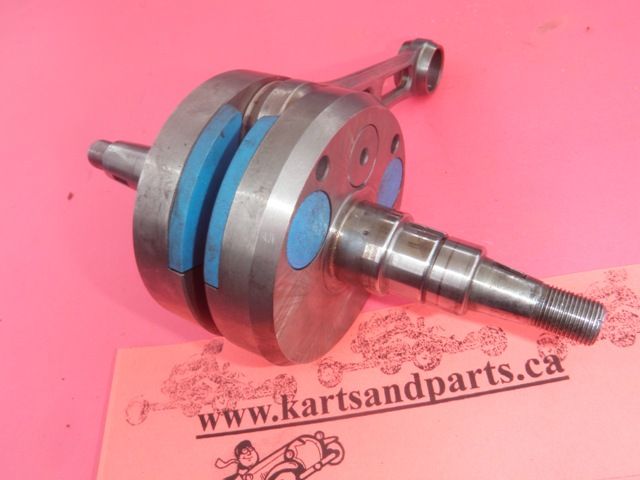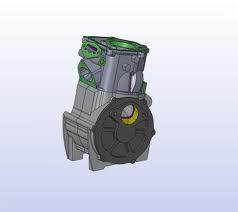expansion chambers is those bulging curvey pipes that you see on two strokes, Motocross and Formula 1 bikes (500GP back then now 2 strokes 'banned', thanks to bullshit politics).
so, these are 'exhaust pipes"/muffler....it is designed in w main ways (mostly a combination of..) tuned lengths (four strokes also have this as 'extractors" that is extracting spent charges for the next combustion cycle...whereas the 2 stroke 'expansion chambers' is not only the length but also timing to send back shock waves to "plug" in the exhaust port to prevent the next-coming fresh charges from being wasted, to maximise the potential to toward te next 2-stroke combustion cycle. (remember 4 strokes goes 4 entire strokes/2 spins of the crank to complete the intake/compress/fire/expell of air/fuel charges where as 2 strokes is effectively done at Every SINGLE full spin of a crank. Not only the 'every' sometimes engineers will exploit this to triple , even quabruple the power strokes for every 360 degrees turns of a crank. (now thats why striaght 6, v8's are "powerful" becuase it is balanced into doing as MUCH POWER per Rev of a crank...
let go back to the exhaust pipe shall we?
2 strokes's pipes (modern ones (not chainsaws you'd Never see it on that as their powerband is zero or everything so narrow it is entirely ported. But for motorcycles ridability is paramount over outright brute output to do this
they need to broaden the powerband. It is done hundreds of ways. Principally, it is achieved with alot of engineering in related to the use od expanision chambers
So many limitations are inherented with 2 strokes becuase of the port's dimensions. it is effectively a 'loose pump' engine design, working best in certain speeds and the rest is just pumping, almost misfiring, barely noticable but at that 'excess ineffecient pumping stages' (one would say below powerband, at idle, close to redline past the useful power-generating curves aka the torque curves' is where its not making power just wasting fuel.
expansion chamber is a poor name but used to conventionally refer to the 'use of expanding hot gases from the 2 stroke's exhausts' comes out EXPLOSIVELY from the the rapid movement of the pistion inside the cylindar, it had little to do with 'pressure' like you might find with 4 strokes's mechanical means of trapping with valves. 2 stroke dont have valve just holes "ports".
the exploding phemonena is like ear-popping , "not the sounding -like' but engine behaving ina way such like...
some clever scientist engneer took the idea that if its a balloon which 'matches the exploding gases from the output hole' and have it to 'blow back' (not the gases but the shockwaves) would hole the output hole SHUT a bit longer....so the piston lifts the fresh charge past the output towards the burning chamber (where the spark plugs are)..all this equals to more power and 'mixing 2-3 or 4 different kinds of 2 stroke engines into ONE single cylindar mould. Yes i said Mould, my own words.you see , in the 2 stroke design, there is transfer ports which 'carries the fresh from compression at the crankshaft side to the over above the piston side, (pistion crown, above the rings).
Hard to explain all this but transfer ports are subjected to various designs also, like 5 ports, 6 or 8 ports, small or big, or the top-side (above piston) is the position high or just below the exhausts.. if high, the transfer is slow, if low the transfer is quick but the efficency is always a problem.
Expansion chambers as made a huge differences....
oh the angles of the muffler side of the chambers decides how 'wide' the effective working range. That is the steeper is will be sharper, more narrower in range of it improvement, shallower might mean less use of the shock waves...also it had to work well with the transfers....grinding transfers helps so much, then get too narrow....then pipes helps it back...the curves and retain the power gained from grinding transfers....
these are just showing how tedious, time consuming of experimentations.
Again Rotary valves is tedious, but more straight forward but more limited in what can be done..
Rotary valves is for the inlets.
Reed valves is for the inlets as well.
Expansion chamber is that snake-like welding funnying looking 2 stroke exhaust pipes.
Often times it is 'funny looking' and often get riddled with strange routing of the pipes and welding traces....thats' because Motorcycle racing is unlike Go kart racing, riders and bikes are subjected to extreme movement problems, cornering low, jumping high bikes landing with forks and back suspension bottoming out....etc etc and Heat, that burns the riders legs is another one too....
That is fabricated on a number of ways, lengths, angles of the expanding, and angles of the (forgot the name of it, last time read the book on this was 20 years ago)...but the closing angle is right before the 'stinger' which is the narrow pipes that leaks out the gases, and left over shockwaves, and works to 'breathe the engine' the expansion chamber pipes itself is more like a working part of the 2 stroke performance engine in itself, its not a 'exhaust' it is a NON Mechanical MEANS to deal with the NON mechanical 'loss' of exhaust pressure controlling appartus that the 4 -strokes engine design enjoys. (4 strokes works alot on with CAMs.....which is timing...duration to open/shut//similarly the rotary valves' approach to decide its duration is done this way also but its whole thinking is entirely different as crank frequency as concept is totally different.
So, there Expansion chamber is shockwave-exploiting device which to alter the "results/personality" that would otherwise be restricted by the actual design of that 2 stroke engine set down by solely the port of the cylinder's chambers in both crankcase pressure and the cylinder head/in between transfers compromises that plagued its balances between 'grabbing as much from the carbs' and 'getting as much from the crank' across the rev range....
simple engines, it is not. but a fascinating one that provokes us to think pass the mechanical problems, it is the more fluid, dynamic we dont 'see' , that is the shockwaves and how we exploit it.
That's the beauty of expansion chambers.

 I know 450cc and 250cc and what your point is?
I know 450cc and 250cc and what your point is?






